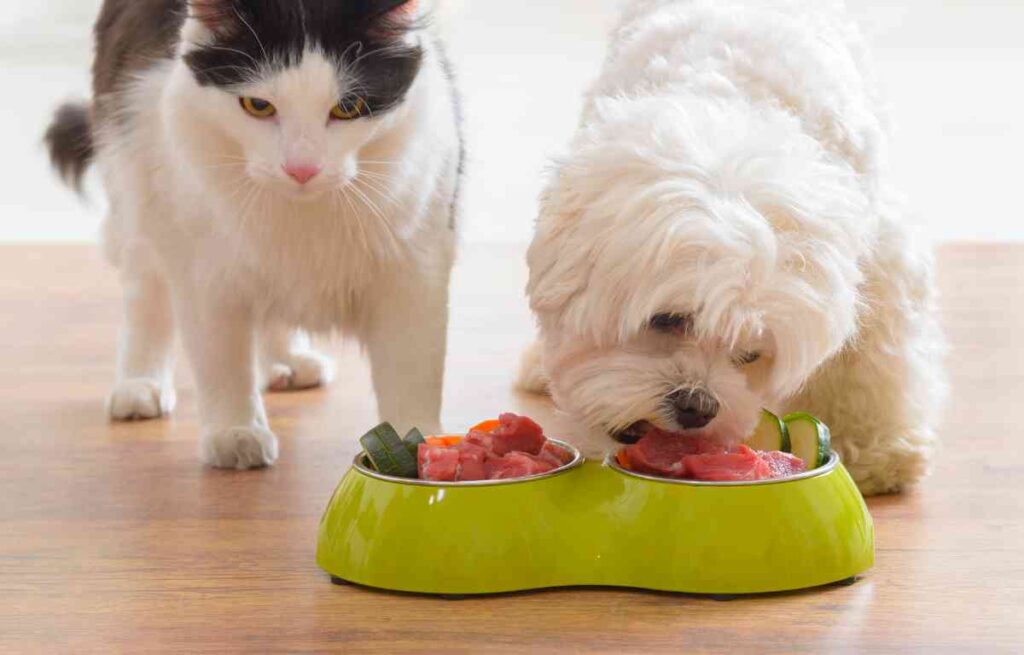Imagine the joy of pampering your furry friend with meals prepared straight from your heart and kitchen. Homemade dog food recipes not only provide tailored nutrition but also foster a deeper bond between you and your beloved canine companion. In this guide, we’ll delve into the world of DIY delights, sharing creative and nutritious recipes that are bound to make those tails wag with excitement.
Table of Contents
1. Introduction
Our four-legged friends hold a special place in our hearts, and what better way to show them love than by preparing delicious and nutritious meals right in our kitchens? Homemade dog food recipes provide a unique opportunity to ensure that your pup gets the best possible nutrition, tailored to their individual needs.

2. Benefits of Homemade Dog Food
The benefits of homemade dog food extend beyond just satisfying hunger. By crafting meals at home, you have complete control over the ingredients, avoiding artificial additives and preservatives often found in commercial options. This can lead to improved digestion, healthier skin and coat, increased energy, and even better dental health.
3. Understanding Nutritional Needs
Before embarking on your DIY dog food journey, it’s crucial to understand your pet’s nutritional requirements. Dogs need a balanced mix of protein, carbohydrates, fats, vitamins, and minerals. Consult your veterinarian to determine your dog’s specific needs based on factors like age, size, and activity level.
4. Key Ingredients for DIY Dog Food
A successful homemade dog food recipe revolves around high-quality ingredients. Lean proteins like chicken, turkey, beef, and fish provide essential amino acids, while carbohydrates from sources like rice, sweet potatoes, and quinoa offer energy. Don’t forget healthy fats from sources like coconut oil and flaxseed.
5. Top 5 Homemade Dog Food Recipes
Recipe 1: Chicken and Sweet Potato Stew
Ingredients:
- 1 cup of boneless, skinless chicken breast (cooked and shredded)
- 1 medium sweet potato (peeled and diced)
- 1/2 cup of carrots (peeled and chopped)
- 1/2 cup of peas (fresh or frozen)
- 1 cup of low-sodium chicken broth
Instructions:
- Start by cooking the boneless, skinless chicken breast. You can boil or bake it until fully cooked. Once cooked, shred the chicken into small, bite-sized pieces.
- In a separate pot, bring the chicken broth to a gentle simmer.
- Add the diced sweet potato and chopped carrots to the simmering chicken broth. Allow them to cook for about 10-15 minutes or until they start to soften.
- Add the peas to the pot and continue to simmer for an additional 5 minutes. Peas cook quickly, so you don’t want to overcook them.
- Once all the vegetables are tender, add the shredded chicken to the pot. Stir everything together to combine.
- Let the stew cool down before serving it to your dog. Make sure the temperature is safe for your dog’s consumption.
- Serve an appropriate portion size based on your dog’s size, age, and dietary needs. You can adjust the portion sizes accordingly.
- Store any leftovers in an airtight container in the refrigerator. Homemade dog food can be refrigerated for a few days. If you want to make larger batches, consider freezing portions for future meals.
Recipe 2: Beef and Brown Rice Delight
Ingredients:
- 1 cup of lean ground beef (cooked)
- 1/2 cup of cooked brown rice
- 1/2 cup of fresh spinach (chopped)
- 1/4 cup of blueberries (fresh or frozen)
- 1 tablespoon of olive oil
Instructions:
- In a skillet, cook the lean ground beef until fully cooked. Drain any excess fat.
- In a bowl, combine the cooked beef, cooked brown rice, chopped spinach, blueberries, and olive oil.
- Mix all the ingredients thoroughly until well combined.
- Allow the mixture to cool down before serving it to your dog.
- Serve an appropriate portion size based on your dog’s size, age, and dietary needs. Adjust portion sizes accordingly.
- Store any leftovers in an airtight container in the refrigerator. You can also freeze portions for later use.
Recipe 3: Veggie-Packed Quinoa Surprise
Ingredients:
- 1/2 cup of cooked quinoa
- 1/2 cup of cooked broccoli (chopped)
- 1/4 cup of bell peppers (chopped)
- 1/4 cup of green beans (chopped)
- 1/4 cup of canned pumpkin (unsweetened)
Instructions:
- In a bowl, combine the cooked quinoa, chopped broccoli, bell peppers, green beans, and canned pumpkin.
- Mix all the ingredients thoroughly to create a balanced mixture.
- Allow the mixture to cool down before serving it to your dog.
- Serve an appropriate portion size based on your dog’s size, age, and dietary needs. Adjust portion sizes accordingly.
- Store any leftovers in an airtight container in the refrigerator.
Recipe 4: Fish and Spinach Medley
Ingredients:
- 1 cup of white fish fillets (cooked and flaked)
- 1/2 cup of spinach leaves (chopped)
- 1/4 cup of carrots (peeled and grated)
- 1 tablespoon of chopped fresh parsley
- 1 teaspoon of fish oil
Instructions:
- Cook the white fish fillets until fully cooked. Flake the fish into small pieces.
- In a bowl, combine the cooked and flaked fish, chopped spinach leaves, grated carrots, chopped parsley, and fish oil.
- Mix all the ingredients thoroughly to create a flavorful medley.
- Allow the mixture to cool down before serving it to your dog.
- Serve an appropriate portion size based on your dog’s size, age, and dietary needs. Adjust portion sizes accordingly.
- Store any leftovers in an airtight container in the refrigerator.
Recipe 5: Pumpkin Peanut Butter Bites
Ingredients:
- 1 cup of oats
- 1/2 cup of canned pumpkin puree (unsweetened)
- 1/4 cup of peanut butter (unsalted and unsweetened)
- 1/2 teaspoon of ground cinnamon
- 1 egg
Instructions:
- Preheat your oven to 350°F (175°C) and line a baking sheet with parchment paper.
- In a bowl, combine the oats, canned pumpkin puree, peanut butter, ground cinnamon, and egg.
- Mix all the ingredients thoroughly until a dough-like mixture forms.
- Roll small portions of the mixture into bite-sized balls and place them on the prepared baking sheet.
- Flatten each ball slightly with a fork or your fingers.
- Bake in the preheated oven for about 15-20 minutes or until the bites are golden brown and firm to the touch.
- Allow the bites to cool completely before serving them to your dog.
- Serve an appropriate portion size based on your dog’s size, age, and dietary needs. Adjust portion sizes accordingly.
- Store the pumpkin peanut butter bites in an airtight container in the refrigerator.
Enjoy preparing these nutritious and delicious homemade dog food recipes for your furry friend! Remember to consult your veterinarian to ensure that the ingredients and portion sizes are suitable for your dog’s individual needs.
6. Cooking Techniques and Tips
The way you prepare the ingredients can greatly influence the nutritional value of your homemade dog food. Opt for cooking methods like boiling, steaming, or baking to retain nutrients. Remember to chop ingredients into appropriately sized pieces for your dog’s comfort.
7. Transitioning to Homemade Food
Switching your dog to homemade food requires a gradual transition. Start by mixing a small portion of homemade food with their regular meal and gradually increase the proportion over a week. This prevents digestive issues and helps your dog adjust to the new diet.
8. Safety Measures to Consider
While homemade dog food is a loving gesture, it’s important to ensure it’s safe. Avoid ingredients toxic to dogs (like onions, garlic, grapes, and chocolate), and always practice proper food hygiene by washing hands and utensils thoroughly.
9. FAQs About Homemade Dog Food
Q1: Is homemade dog food suitable for all breeds?
A1: Homemade dog food can be tailored to suit most breeds, but it’s important to consult your veterinarian before making the switch. Different breeds have varying nutritional requirements, and a vet can guide you on the best approach to ensure your dog’s health and well-being.
Q2: Can I replace commercial treats with homemade ones?
A2: Absolutely! Homemade treats can be a healthier alternative to store-bought options, as you have control over the ingredients. Just ensure that the treats are safe and suitable for your dog’s size and dietary needs. Always introduce new treats gradually and monitor for any adverse reactions.
Q3: How do I know if my dog is getting all the necessary nutrients?
A3: Balancing nutrients in homemade dog food is crucial. Work closely with your veterinarian or a veterinary nutritionist to formulate recipes that meet your dog’s specific requirements. They can help ensure your recipes include the right amounts of protein, carbohydrates, fats, vitamins, and minerals for your dog’s age, weight, and activity level.
Q4: Can I add supplements to homemade dog food?
A4: Yes, supplements can be beneficial, but it’s important to consult your vet before introducing any. Common supplements include omega-3 fatty acids for skin and coat health, joint supplements for mobility, and multivitamins to fill potential nutritional gaps. Over-supplementing can be harmful, so professional guidance is essential.
Q5: Are there any specific ingredients I should avoid in homemade recipes?
A5: Some ingredients are toxic to dogs and should be avoided, including onions, garlic, grapes, raisins, chocolate, and certain artificial sweeteners like xylitol. High-fat foods can lead to pancreatitis, and bones that splinter easily can cause choking or internal damage. Always research ingredients before use.
10. Conclusion
Crafting homemade dog food is an act of love that promises a healthier and happier life for your furry companion. By understanding their nutritional needs and experimenting with recipes, you’re giving your dog the best of both taste and health. So roll up your sleeves, put on that apron, and let the tail-wagging adventure begin!


